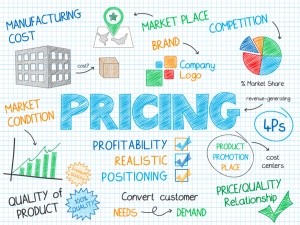
Pricing Methods 1 comment

What is Pricing?
Pricing is a term used by firms when setting the selling price of their products. Usually Pricing Strategies are put in place for the company to select a price which is fair for the product in question.
Price is based on a number of things. For example, a business will evaluate how much it costs to produce the product, the average costs of the firm, and the average market price of the same or a similar product by competitors.
What are Pricing Methods?
Pricing methods describe the ways in which the price of goods and services are determined by taking into consideration all the factors. These factors may include the product, service, competition, target audience, product’s life cycle, firm’s vision of expansion etc., and influences the pricing strategy as a whole.
Pricing methods can be broadly categorized in two parts:
Cost-Oriented Pricing Method: Many companies consider the cost of production as an indication or determiner for the price of the finished goods. Cost-oriented pricing covers cost-plus pricing, markup pricing, and target-return pricing.
Market-Oriented Pricing Method: On this method, price is calculated on the basis of market conditions. Market-oriented pricing covers perceived-value pricing, value pricing, going-rate pricing, auction type pricing, and sealed-bid auctions.
Companies undertake either of these methods depending on the type of product they offer and the ultimate objective for which the pricing is being done.
For more on pricing methods, click here
Pricing Strategies
There are many different Pricing Strategies, these vary in terms of where the emphasis is put for selection, estimation, comparative analysis, evaluation of costs, and the market situation. Here are some examples of pricing strategies:
Penetration Pricing: The starting price is set extremely low- lower than is normal- in order to gain market share and persuade customers or clients to choose their product over the competitors' products that they may normally purchase. After the business has achieved this, increasing its market share, it is able to choose a more profitable price. For more on penetration pricing visit this webpage.
Premium Pricing: Where there is a unique brand, the business charges a high price in the knowledge that they have a substantial competitive advantage. By marketing their product as higher in value, customers may perceive the product to be higher in value, whilst also having a higher profit margin.
Economy Pricing: Low prices. Costs are kept low in production in order to keep down the selling price. Other overheads, such as marketing their product and branding, are also low cost. This allows the product to be priced lower in comparison to competitors, whilst still retaining a healthy profit margin.
Value Pricing: This strategy is used where external factors force businesses to provide value products and services e.g. a recession or increased competition. This strategy makes it seem like you are getting a lot for your money.
Price Skimming: This is where a business chooses a high price for their product, which is often newly launched, and has little to no competition. Consumers will be willing to pay the higher price in order to have the advanced product. This strategy does not, however, last long due to a gradual increase in competition over time.
Geographical Pricing: Simply, geographical pricing is a strategy whereby the seller will alter the price depending on where the buyer is located. This may be due to shipping costs, different operating costs, or competitors pricing in that particular location perhaps due to what the customer is willing to pay.
Product Line Pricing: When there is a range of products or services, the customer expects to pay for what is fair incrementally over the range. In this way, the pricing of this strategy rarely reflects the cost of making the product. For example, in an ice cream cabinet, some flavours could be a lot more expensive to produce than others, however consumers expect to pay the same price for all of the ice cream, and more only if the quantity increases.
Promotional Pricing: This strategy is well-known and is where prices are reduced or offered for free as part of a deal. This is adopted in order to attract customers and increase sales volume. This includes sales, buy one get one free, special offers, vouchers, discounts etc. Although bringing in more customers, promotional pricing also reduces profit margins.
Product Bundle Pricing: Another form of promotional pricing. Often used to shift old stock or slow-selling items by selling them together (at a lower price) with better selling items.
Captive Product Pricing: When you buy a product for a cheap price but the essential components that are required to make the item useful are sold at an expensive price.
Optional Product Pricing: Including pricey optional extras to offer with a low-cost product or service.
Why is Pricing Key for a Business?
Pricing can make or break a business. It is one of the biggest factors when it comes to offering products and services, and usually determines popularity. It must be well thought out and researched so that you benefit from high returns. If you’d like to read more about pricing, have a look at these links:
On pricing strategies: by Marketing Teacher
For more on pricing methods: by Lumen
For advice on pricing: by Inc.
Most popular Methods
 Price volume mix analysis (PVM) excel template to better understand your sales and improve pricing strategy.15,14511add_shopping_cart$59.00
Price volume mix analysis (PVM) excel template to better understand your sales and improve pricing strategy.15,14511add_shopping_cart$59.00 by HEURTEBIZE
by HEURTEBIZE

Pricing Model with Van Westendorp PSM and Newton Miller and Smith's Extension Template
Pricing Model with Van Westendorp PSM and Newton Miller and Smith's Extension, Price Range, Revenue Max, Marginal prices3,798Discussadd_shopping_cart$30.00 by Jair Almeida
by Jair Almeida

Pricing Positioning - Industry Competitor Analysis Template Slide
A PowerPoint Slide for any business to compare the average price, and price range of its offering versus competition.2,689Discussadd_shopping_cart$7.00
 by Tim Demoures
by Tim Demoures

Van Westendorp’s Pricing Method
Determines optimal and acceptable price points, plots demand curves, estimates revenue maximisation points1,104Discussadd_shopping_cart$12.00 by Andrei Okhlopkov
by Andrei Okhlopkov

Price-Volume-Mix Analysis
A comprehensive full-scope model to analyse revenue and profit changes2,901Discussadd_shopping_cart$50.00 by Andrei Okhlopkov
by Andrei Okhlopkov

Maximized Margin & Revenue Pricing Analysis
Determines optimal sales price for highest profitability, based on comparison of sales (demand) at two price points.589Discussadd_shopping_cart$15.00 by Shane Shepherd
by Shane Shepherd








